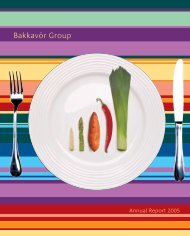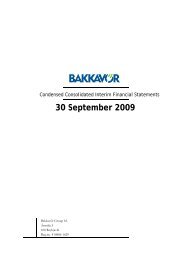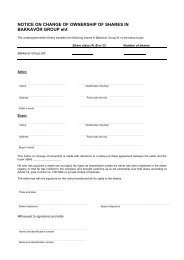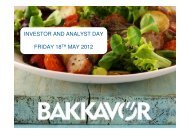Download our latest Annual Report - Bakkavor
Download our latest Annual Report - Bakkavor
Download our latest Annual Report - Bakkavor
Create successful ePaper yourself
Turn your PDF publications into a flip-book with our unique Google optimized e-Paper software.
BAKKAVOR ANNUAL REPORT AND ACCOUNTS 2012<br />
notes to the consolidated financial statements<br />
continued<br />
2<br />
SIGNIFICANT ACCOUNTING POLICIES CONTINUED<br />
Property, plant and equipment<br />
All property, plant and equipment is stated in the statement of financial position at cost less any subsequent accumulated depreciation and<br />
subsequent accumulated impairment losses.<br />
Depreciation is charged so as to write off the cost or valuation of assets, other than land and properties under construction, over their estimated<br />
useful lives, using the straight-line method, on the following bases:<br />
Buildings – maximum period of 50 years<br />
Plant and machinery – 1 to 20 years<br />
Fixtures and equipment – 3 to 5 years<br />
Freehold land is not depreciated. Most plant and machinery is depreciated over 12 years.<br />
Assets held under finance leases are depreciated over their expected useful lives on the same basis as owned assets or, where shorter, over the term<br />
of the relevant lease.<br />
Reviews of the estimated remaining useful lives of and residual values of individual productive assets are performed annually, taking account of<br />
commercial and technological obsolescence as well as normal wear and tear. All items of property, plant and equipment are reviewed for impairment<br />
when there are indications that the carrying value may not be recoverable.<br />
The gain or loss arising on the disposal or retirement of an asset is determined as the difference between the sale proceeds and the carrying amount<br />
of the asset and is recognised in the income statement.<br />
Impairment<br />
The useful economic lives of intangible assets are determined based on a review of a combination of factors including the asset ownership rights and<br />
the nature of the overall product life cycle.<br />
Intangible assets and property, plant and equipment are tested for impairment when an event that might affect asset values has occurred. Examples<br />
of such triggering events include significant planned restructuring, a major change in market conditions or technology, expectations of future operating<br />
losses, or a significant reduction in cash flows.<br />
An impairment loss is recognised, in the income statement, to the extent that the carrying amount cannot be recovered either by selling the asset or<br />
by the discounted future earnings from operating the assets in accordance with IAS 36 “Impairment of Assets”.<br />
Inventories<br />
Inventories are stated at the lower of cost and net realisable value. Cost comprises direct materials and, where applicable, direct lab<strong>our</strong> costs and<br />
those overheads that have been incurred in bringing the inventories to their present location and condition. Cost is calculated using the weighted<br />
average method. Net realisable value represents the estimated selling price less all estimated costs of completion and costs to be incurred in<br />
marketing, selling and distribution.<br />
Assets held under leases<br />
Leases are classified as finance leases whenever the terms of the lease transfer substantially all the risks and rewards of ownership to the lessee.<br />
All other leases are classified as operating leases.<br />
Finance leases<br />
Assets held under finance leases are recognised as assets of the Group at their fair value or, if lower, at the present value of the minimum lease<br />
payments, each determined at the inception of the lease. The corresponding liability to the lessor is included in the statement of financial position<br />
as a finance lease obligation. Lease payments are apportioned between finance charges and reduction of the lease obligation so as to achieve a<br />
constant rate of interest on the remaining balance of the liability. The interest element of the finance cost is charged to the income statement over<br />
the lease period.<br />
Operating leases<br />
Rentals payable under operating leases are charged to income on a straight-line basis over the term of the relevant lease. Benefits received and<br />
receivable as an incentive to enter into an operating lease are also spread on a straight-line basis over the lease term. Income earned from operating<br />
leases is credited to the income statement when earned.<br />
PAGE 62 VIEW THE FULL REPORT AT ANNUALREPORT12.BAKKAVOR.COM










